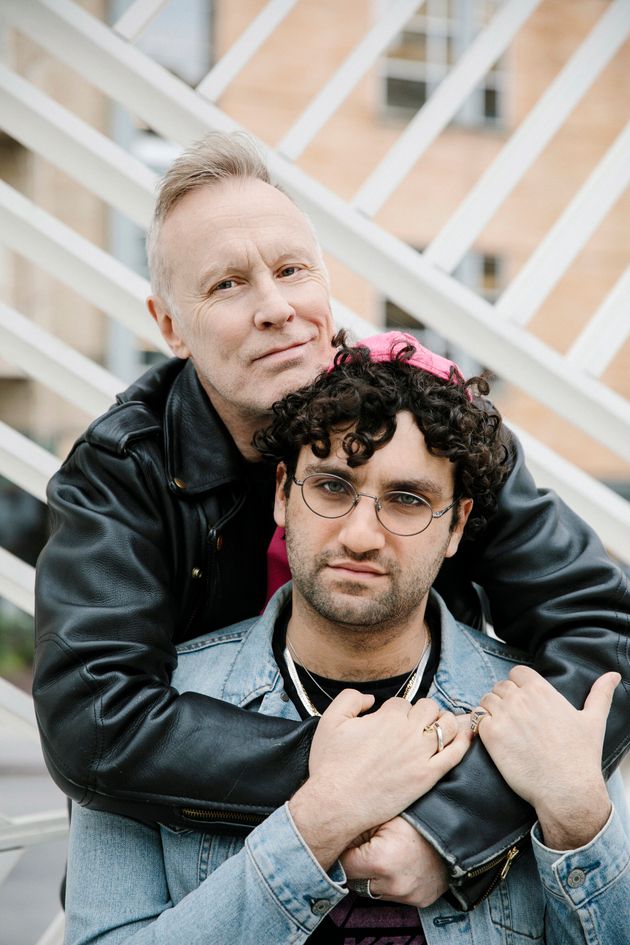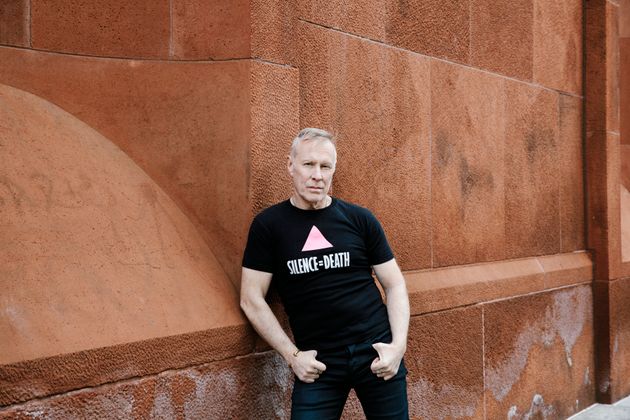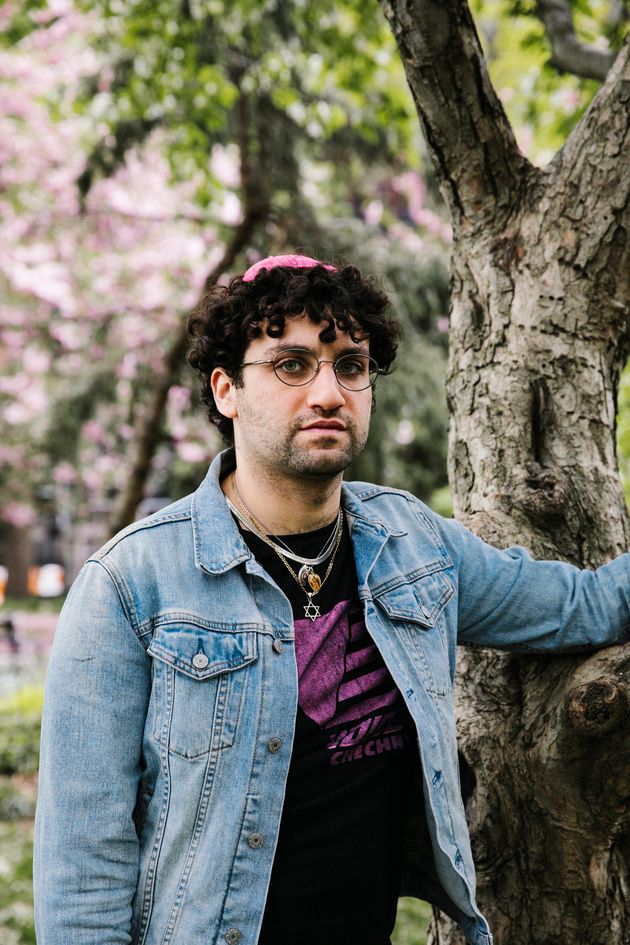
Photos by Laurel Golio
In 2016, Adam Eli was 25 years old and working as a real estate agent in New York seven years after coming out. “That was the time of Lady Gaga, ‘Glee,’ #ItGetsBetter,” he says. “I was like, ‘OK, things are great now.’”
Then, on June 12, the Pulse nightclub shooting happened. “The news was unfolding throughout the day, [and] it kept on getting worse. I was beside myself,” Eli recounts.
So he started posting on Instagram and Facebook. “I didn’t know what else to do. I’m thinking, I guess that’s what millennials do.” He posted messages of strength and urged people to call their queer friends and tell them they loved them. People messaged him back asking him what to do. “I was like, how should I know?”
The following night, organisers held a vigil in front of the Stonewall Inn in New York City. Eli posted on Instagram that if anyone felt sad, alone and upset, they could meet him at Two Boots Pizza nearby and go to the vigil together. He had a little over 1,000 followers at the time; 35 people showed up. “It made me realise: Oh, there is power. It turns out people can be organised through social media. I didn’t know that.”
A couple of evenings later, Eli found himself at the LGBT Centre for the first meeting of an activist group that would eventually become Gays Against Guns (GAG). Most of the participants were significantly older than he was. “It became very clear to me that I was in a room with a group of very sophisticated AIDS and marriage activists [and] that I should shut up and listen. I watched them build a group from nothing.”
But one thing the emerging group didn’t have was expertise in how to use social media. So when the call went out for anyone who could assist with that, Eli’s hand shot up. “And the next day, I became Gays Against Guns’ social media manager,” he says. “I did the Instagram, Instagram Live and Facebook, all live photos.”
Eli began posting the group’s actions and creating its social media presence. “The rest of the folks, they weren’t super social media-proficient, so anything I did, they were like, ‘This is amazing!’ The truth is, I’m sure some of it was not amazing, but they were so grateful and so supportive.”
It became very clear to me that I was in a room with a group of very sophisticated AIDS and marriage activists [and] that I should shut up and listen.Adam Eli, LGBTQ activist
Over that summer and into the first months of the Trump presidency, Eli evolved from a rookie into one of today’s most effective young queer activists. As a member of GAG, Eli learned invaluable lessons from older LGBTQ activists, re-engineering tactics for our multi-platform smartphone culture. And he did it quickly. During GAG’s event for the one-year anniversary of the Pulse nightclub shooting, he increased the group’s following by one-third in an evening. In 2017, Eli created Voices4 ― an activist group that harnesses social media to combat global injustice against queer people from Brunei to Chechnya.
In August 2016, GAG assembled its biggest demonstration yet, a “die-in” at the Manhattan headquarters of BlackRock, one of the largest shareholders of stock in civilian gun-makers. The protesters occupied BlackRock’s lobby for almost an hour.
The lead organiser of that demo was GAG member Ken Kidd, a veteran of ACT UP and a founding member of Queer Nation.
“He was one of the ones yelling the loudest, physically leading the protest, being really aggressive in a good way,” remembers Eli, who was filming everything. “Ken always carries cowbells, and that way, you can always find him.”
Queer activism, it turns out, has good bone structure. Many of the tactics Queer Nation and ACT UP used 30 years ago are, surprisingly, still relevant ― and effective.
Over the next few months, GAG mounted dozens of demonstrations. From its inception, the group’s goal was to follow the money flowing in and out of the gun industry — to and from politicians, lobbyists and corporations — what Kidd calls “the chain of death.”
Along the way, Eli got a crash course in civil disobedience. “I watched Ken lead tons of protests. I watched him yell. I watched him engage. I watched him scream and stand in the street, asking for empathy. He would be like, ‘How many more have to die? Why don’t you care? Why are you not marching with us?’”

Kidd, now the director of special projects and events for the College of Arts and Science at New York University, began working for the school as a secretary in 1979, when he was around Eli’s age. Back then, Kidd was “still living in my world, fresh and blonde … I was getting my first apartment and my first credit card. It was a time when everyone kept saying yes to me. Yes, you can have the job. Yes, you can hook up. Yes, you can live openly as a gay man.”
Then, one night in the early ’80s, Kidd was gay-bashed by three men. Shortly afterward, his friends started dying. “The no’s started happening,” he recounts. “No, you aren’t safe. No, there is no research. No, Reagan won’t acknowledge us.”
Kidd found himself attending numerous candlelight vigils and fundraisers. “GMHC was having things like the Gay Rodeo that people would go to to raise money for research. But of course, it was a drop in the bucket. It wasn’t nearly enough. And we weren’t nearly mad enough at that point. I credit Larry Kramer for telling us that we had every fucking right to be angry.”
ACT UP, Kidd explains, was formed “in order for us to say yes again. We took a lot of our tactics and inspiration from the civil rights movement, from people who had been told no all their lives.”
Kidd recalls being a quick study back then, like Eli. There was no time to waste. “The hourglass [was] turned over on the table, and nobody knows how much time we all have, and so those Monday night meetings of ACT UP were crowded.” The urgency was real. “Because literally from one week to the next, a comrade that you screamed your lungs out with at the NIH could be dead.”
Now, on the other side of countless demonstrations ― including ACT UP’s famous “Stop the Church” protest at St. Patrick’s Cathedral in 1989 as well as the Day of Desperation protest in 1991 in which hundreds of protesters shut down Grand Central and Times Square ― Kidd talks about anger as an essential energy for activism. “[When] I watch one of my friends get pissed off it, it makes me feel pissed off and that impact empowers me, enlightens me. It’s very possible to feel love and anger at the same time.”
I watched Ken lead tons of protests. I watched him scream and stand in the street, asking for empathy. He would be like, ‘How many more have to die? Why don’t you care?’Eli
Five months after the Pulse shooting, Donald Trump was elected president of the United States. At first, Kidd had a hard time channeling that essential activist anger. “I was furious with so many people, but I hadn’t been able to crystallise my thoughts into who to be mad at first then. But I knew, even that night, that we would be protesting in the streets, and that I was not about to let this go lying down. I knew that I would be calling back on the skills that I had learned in ACT UP and Queer Nation.”
So along with other veterans of ACT UP, Kidd helped found Rise and Resist, a direct action group targeting the Trump administration. “We put into our mission statement, ‘with all the joy we can muster,’ because they want us to be upset and angry and sad and helpless. We’re not hopeless. We are offering hope to one another, and we’re offering hope for the greater community.”
Meanwhile, GAG was still active, and Kidd was involved in both organisations.

The post-election period saw a series of protests. “There was the Love Trump Hate protest the weekend he got elected, the Women’s March, the reaction to the travel ban, the Planned Parenthood scare, trans kids in the bathrooms,” says Eli. In terms of social media activism, “I was five months ahead of other people, and so I used the skills that I learned at GAG to galvanise people together.”
That involved tapping into direct actions from queer activism’s past. Eli read online about ACT UP’s media department, DIVA TV, and how members would take camcorders to protests and film as much as possible. “Then they would go home, put those on VHS and then send them to news stations, to their parents, and other people around the country. Like: ‘Hi, the media is not telling our story, here is what is actually happening!’ Can you imagine what the fuck these people would have done with streaming live?”
Another tactic he learned about was the ‘fax bomb’ — blitzing a target en masse through messaging, freezing their communications. When it emerged that the upcoming World Cup had training camps in Chechnya, Voices4 decided to target Budweiser, one of the sponsors that had been pro-gay in its advertising. Using the hashtag #PrideOverGenocide, Voices4 encouraged thousands to send Budweiser the message “You can celebrate Pride or support our Genocide.”
“We shut down their Instagram during their biggest marketing period for 10 days, because we flooded the Instagram sections with comments,” says Eli. “We got their attention.”
We put into our mission statement, ‘with all the joy we can muster,’ because they want us to be upset and angry and sad and helpless. We’re not hopeless. We are offering hope to one another, and we’re offering hope for the greater community.Ken Kidd, veteran ACT UP and Queer Nation activist
Another veteran of ACT UP and Queer Nation, broadcast journalist and activist Anne Northrop, came to GAG to lead a media training workshop, as she has done for countless social justice groups. Her adage, “talk through the media,” has become a mantra for the queer activist community, as is her advice to only talk in 13-second sound bites.
“The news stations would only run a 13-second sound bite,” recalls Eli, “So at ACT UP, they would all practice the sound bite that they’re going to give, and then you just say that.” The 13-second sound bite and the Instagram post aren’t that different.
What is different is the ability to communicate directly to followers on social media. “Is our [Budweiser] protest in The New York Times? No, but that doesn’t matter if you’re Googling. Social media has put my queer generation in a unique place where we have the ability to talk to queer people all over the world,” Eli says.

Last year, Voices4 staged a kiss-in to stand in solidarity with persecuted LGBTQ+ people in Uzbekistan, Tajikistan and Azerbaijan. This year, it joined the global outcry that led to the Sultan of Brunei’s moratorium on death by stoning for homosexual activity. Last month, Rise and Resist continued its series of silent demonstrations against the Trump administration’s immigration policies with a protest outside of Fox News. And ACT UP, still very active, most recently organising a protest against Gilead’s price hikes of HIV and hepatitis meds.
No matter how digital we get, these queer activists understand the importance of physical presence in the face of oppression. “The physical body, it’s a body of knowledge. It’s the body of unity. It’s the body of a community. Who knows who’s going to see it, who knows what’s going to happen, but it’s the body being there,” says Kidd.
“I really truly believe in my heart of hearts that ACT UP and the civil disobedience that it inspired, whether it was medication for HIV or the folks who sat in and protested for marriage equality, none of that stuff would have made headway had it not been for civil disobedience,” he says.
On the wall in Kidd’s office is a framed proclamation from the New York City Council commending his outstanding service to the LGBTQ community. It includes a special citation of his work as one of the coordinators of The Day of Desperation. “Now there’s a sign times have changed,” he laughs.
The world may feel dizzying now with its numerous platforms and relentless news — and what we face may seem insurmountable — but there’s something assuring about the legacy of queer activism. At its core is the same anger, the same tenacity, and, after all these years, the same understanding that silence still equals death.
The interview is part of HuffPost’s Proud Out Loud project, which profiles the next generation of LGBTQ change-makers from around the world to mark 50 years since the Stonewall Riots.